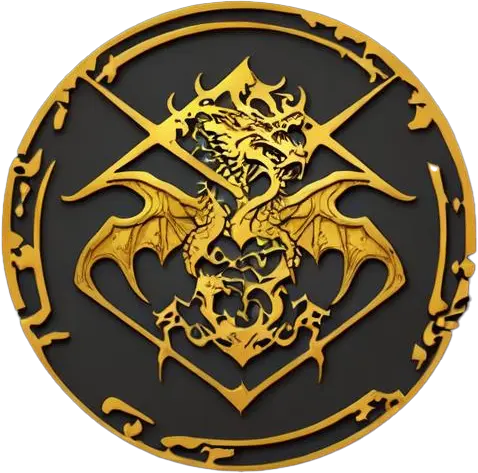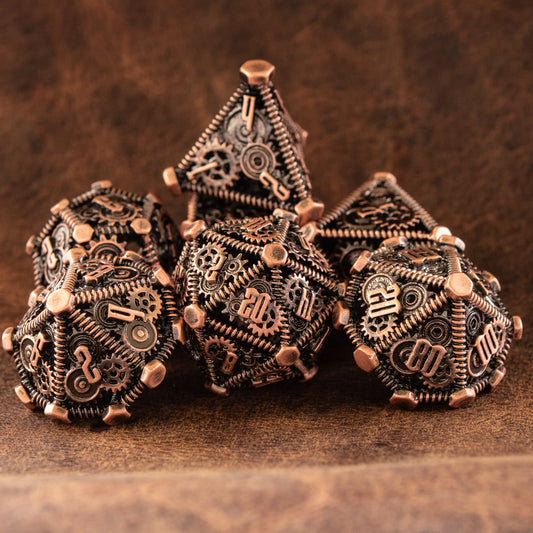Understanding When to Use What Dice in D&D
Share
Understanding When to Use What Dice in D&D
Introduction to Dungeons & Dragons (D&D) and the Importance of Dice in Gameplay
Dungeons & Dragons (D&D) is a renowned tabletop role-playing game that has captivated players for decades. Central to the immersive experience of D&D is the use of various dice, which are essential for determining the outcomes of actions, combat, and other in-game events. The dice add an element of unpredictability and excitement, making each game session unique and engaging.
Brief Overview of the Different Types of Dice Used in D&D
In D&D, a standard set of dice includes seven different types: the d4, d6, d8, d10, d12, d20, and d100. Each die has a specific purpose and is used in different scenarios throughout the game. Understanding when to use what dice in D&D is crucial for both new and experienced players to enhance their gameplay experience.
Purpose of the Article: To Explain When to Use Each Type of Dice in D&D
This article aims to provide a comprehensive guide on the various types of dice used in D&D, their primary uses, probabilities, and examples of when to use each type. Whether you're a seasoned player or a newcomer, this guide will help you master the art of dice rolling in D&D.
The d10 (Pentagonal Trapezohedron)
Description and Shape of the d10
The d10, or pentagonal trapezohedron, is a ten-sided die with each face shaped like a kite. It is numbered from 0 to 9, with the 0 typically representing the number 10.
Primary Uses in D&D
- Damage for Certain Weapons: The d10 is commonly used to determine the damage dealt by certain weapons, such as the longsword or the heavy crossbow.
- Hit Die for Some Classes: Classes like the fighter, paladin, and ranger use the d10 as their hit die to determine their hit points.
- Percentile Rolls: When combined with another d10, it is used for percentile rolls, which can generate numbers ranging from 1 to 100.
Probability and Average Roll
The probability of rolling any specific number on a d10 is 10%, and the average roll is 5.5.
Examples of When to Use the d10
- Rolling for damage with a longsword or heavy crossbow.
- Determining hit points for fighters, paladins, and rangers.
- Making percentile rolls for random outcomes or effects.
The d12 (Dodecahedron)
Description and Shape of the d12
The d12, or dodecahedron, is a twelve-sided die with each face shaped like a pentagon.
Primary Uses in D&D
- Damage for Large Weapons: The d12 is primarily used for determining damage dealt by large weapons, such as the greataxe.
- Barbarian Hit Die: Barbarians use the d12 as their hit die, reflecting their high resilience and toughness.
Probability and Average Roll
The probability of rolling any specific number on a d12 is approximately 8.33%, and the average roll is 6.5.
Examples of When to Use the d12
- Rolling for damage with a greataxe or lance.
- Determining hit points for barbarians.
- Calculating damage for certain spells like poison spray.
The d20 (Icosahedron)
Description and Shape of the d20
The d20, or icosahedron, is a twenty-sided die with each face shaped like an equilateral triangle. It is the most iconic die in D&D.
Primary Uses in D&D
- Attack Rolls: The d20 is rolled to determine if an attack hits its target.
- Saving Throws: Players roll a d20 to see if they can avoid or reduce the effects of harmful spells or abilities.
- Skill Checks and Ability Checks: The d20 is used to determine the success of various actions, such as picking a lock or persuading a character.
Probability and Average Roll
The probability of rolling any specific number on a d20 is 5%, and the average roll is 10.5.
Examples of When to Use the d20
- Making attack rolls to hit enemies.
- Rolling saving throws to resist spells or effects.
- Performing skill checks for actions like stealth or perception.
The d8 (Octahedron)
Description and Shape of the d8
The d8, or octahedron, is an eight-sided die with each face shaped like an equilateral triangle.
Primary Uses in D&D
- Damage for Moderate Weapons: The d8 is used to determine damage for weapons like the longsword (when used one-handed) and the battleaxe.
- Hit Die for Certain Classes: Classes such as the cleric and the bard use the d8 as their hit die.
Probability and Average Roll
The probability of rolling any specific number on a d8 is 12.5%, and the average roll is 4.5.
Examples of When to Use the d8
- Rolling for damage with a longsword or battleaxe.
- Determining hit points for clerics and bards.
- Calculating damage for certain spells like cure wounds.
Understanding D&D Dice
Explanation of the Standard 7-Dice Set Used in D&D
A standard D&D dice set includes the following:
- d4 (Tetrahedron)
- d6 (Cube)
- d8 (Octahedron)
- d10 (Pentagonal Trapezohedron)
- d12 (Dodecahedron)
- d20 (Icosahedron)
- d100 (Percentile Dice)
Importance of Knowing Which Dice to Use and When
Understanding when to use what dice in D&D is vital for smooth gameplay. Each die serves a specific purpose, and knowing which one to roll can significantly impact the outcome of actions and combat scenarios.
Overview of Each Die: d4, d6, d8, d10, d12, d20, and d100
- d4: Used for minor damage and small effects.
- d6: Commonly used for simple weapons, hit die for fragile classes, and multiple rolls for spells.
- d8: Used for moderate weapon damage and hit die for certain classes.
- d10: Used for certain weapon damage, hit die for some classes, and percentile rolls.
- d12: Used for large weapon damage and barbarian hit die.
- d20: Used for attack rolls, saving throws, skill checks, and ability checks.
- d100: Used for determining random outcomes, primarily by Dungeon Masters.
By mastering the use of these dice, players can enhance their D&D experience and make more informed decisions during gameplay.
Choosing the Right Dice for Your Character
In Dungeons & Dragons (D&D), the type of dice you use can significantly impact your gameplay experience. Different classes and characters rely on various dice to perform actions, deal damage, and cast spells. Understanding when to use what dice in D&D is crucial for maximizing your character's potential.
How Different Classes and Characters Rely on Different Dice
Each class in D&D has specific dice that are commonly used based on their abilities and actions:
- Barbarians: Often use the d12 for their hit die and weapon damage, especially with weapons like the greataxe.
- Wizards: Typically use the d6 for their hit die and spell damage, such as with the iconic fireball spell.
- Rogues: Frequently use the d8 for weapon damage with weapons like rapiers and shortswords.
- Paladins: Use the d10 for hit die and weapon damage, particularly with versatile weapons like the longsword.
Examples of Class-Specific Dice Usage
- Barbarians: When a barbarian uses a greataxe, they roll a d12 to determine the damage dealt. Their hit die is also a d12, reflecting their high durability.
- Wizards: A wizard casting fireball will roll multiple d6s to determine the spell's damage. Their hit die is a d6, indicating their lower hit points compared to other classes.
- Rogues: When a rogue attacks with a rapier, they roll a d8 to determine the damage. Their sneak attack ability also involves rolling multiple d6s.
- Paladins: A paladin using a longsword with two hands rolls a d10 for damage. Their hit die is a d10, showcasing their robust nature.
Advice on Selecting Dice Based on Character Build and Play Style
When choosing dice for your character, consider the following:
- Character Class: Select dice that align with your class's primary abilities and actions.
- Play Style: If you prefer dealing massive damage, focus on dice like the d12 and d10. For versatility and multiple attacks, the d6 and d8 are more suitable.
- Character Build: Tailor your dice selection to complement your character's strengths. For example, a fighter specializing in heavy weapons will benefit from the d12, while a spellcaster will rely on the d6 and d8 for spell damage.
Combining Dice Rolls
In D&D, combining multiple dice rolls is a common practice to determine the outcome of various actions. Understanding how to manage these rolls is essential for both new and experienced players.
Explanation of How Multiple Dice Are Used Together in D&D
Multiple dice are often rolled together to calculate damage, healing, or other effects. For example, a fireball spell may require rolling 8d6 to determine the total damage dealt to enemies within its radius.
Examples of Common Combinations
- Damage Rolls: A greatsword attack might involve rolling 2d6 for damage, while a spell like magic missile could require rolling multiple d4s.
- Healing Spells: Spells like cure wounds may require rolling a d8 plus a modifier to determine the amount of healing.
- Skill Checks: Sometimes, advantage or disadvantage requires rolling two d20s and taking the higher or lower result, respectively.
Tips for New Players on Managing Multiple Dice Rolls
- Use a Dice Tray: To keep dice rolls contained and organized, use a dice tray or mat.
- Group Similar Dice: When rolling multiple dice of the same type, group them together to make counting easier.
- Record Rolls: Keep a notepad or digital device handy to record the results of complex rolls, especially during intense combat scenarios.
Digital Alternatives to Physical Dice
While physical dice add a tactile element to D&D, digital alternatives offer convenience and additional features.
Overview of Digital Dice Rolling Options
- Apps: Various apps are available for both iOS and Android devices, offering virtual dice rolls with customizable options.
- Virtual Assistants: Tools like Google Assistant and Siri can roll dice on command, providing quick results without physical dice.
- Online Platforms: Websites and virtual tabletops like Roll20 and D&D Beyond offer integrated dice rolling features for online play.
Pros and Cons of Digital vs. Physical Dice
-
Digital Dice:
- Pros: Convenient, quick results, customizable, and often integrated with character sheets.
- Cons: Lacks the tactile experience, potential technical issues.
-
Physical Dice:
- Pros: Tactile and immersive, no technical issues, collectible.
- Cons: Can be lost or damaged, requires space to roll.
Recommendations for Digital Tools and Resources
- D&D Beyond: Offers integrated dice rolling with character sheets and campaign management.
- Roll20: Provides virtual tabletop features with built-in dice rolling for online sessions.
- Dice Roller Apps: Apps like "Dice by PCalc" and "DnDice" offer customizable dice rolling options for mobile devices.
Conclusion
Understanding when to use what dice in D&D is essential for optimizing your gameplay experience. By selecting the right dice based on your character's class and play style, managing multiple dice rolls effectively, and exploring digital alternatives, you can enhance your D&D sessions. Apply this knowledge in your next game, share this article with fellow adventurers, and delve deeper into the world of D&D for more tips and strategies. Happy rolling!

